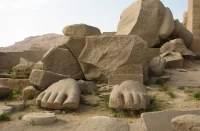
In 1854, the English artist William Holman Hunt presented a painting he called The Light of the World before the court of public opinion. It illustrates a famous verse from the Book of Revelation (3:20): “Behold, I stand at the door and knock.” In the picture, Christ is knocking on a door at night. He is a wayfarer. Just as in the days of his earthly life, He has nowhere to “lay His head.” On that head He wears a crown of thorns, on His feet – sandals, and in His hands – a lantern. The night symbolizes the mental darkness in which we are accustomed to living. This is the “darkness of this world.” The door on which the Savior is knocking has not been opened in a long time. A very long time. This can be seen by the thick weeds that have grown up around the doorstep.
When the painting was first exhibited, the British public did not understand its meaning and were not receptive to it. They – whether Protestants or agnostics – imagined that they could see in the picture the heavy-handed stylistics of Catholicism. And, as often happens, someone eventually had to elucidate the meaning of the canvas, after examining it carefully and with discernment, deciphering it and reading it like a book. The critic and poet John Ruskin acted as that astute interpreter. He explained that the canvas was allegorical, that Christ is still treated like a beggar going door to door, and that the most important element in the picture is the house, which represents our heart, the doors of which lead into the depths where our innermost self lives. It is at that door – the door to our heart – that Christ is knocking. He does not break it down, as He might in his power as the Ruler of the World. He does not shout, “Hey, open up!” And he does not pound on the door with his fist, but merely taps at it delicately with the tips of his fingers. Do not forget that the house is surrounded by the darkness of night … And we are in no hurry to open the door … And on Christ’s head lies a crown of thorns.
Let’s step back for a moment to say a few words about the many imitations and variations on this theme. You must have seen them. They differ from the original in that, first of all, the element of nighttime has been removed. In these, Christ knocks at the door of a house (you have to guess that this is the heart) in the middle of the afternoon. Behind His back an eastern landscape or a cloudy sky is visible. The picture is pleasing to the eye. Because a lantern would be useless, the Savior is holding the staff of the Good Shepherd. The crown of thorns has vanished from His head (!). The eloquently overgrown weeds have been removed from the door at which the Lord is knocking, which means that it is opened on a regular basis. Obviously a milkman or mailman calls at that door every day. And in general the houses in these pictures tend to be clean and tidy – in accordance with the middle-class canons of the “American dream.” In some images Christ is simply smiling, as if he has come to visit a friend who is expecting Him, or even as if He is about to play a trick on the residents and will run off and hide around the corner after knocking. As is often the case in imitative or stylized works, the tragic and profound semantic content imperceptibly gives way to a sentimental schmaltz, in effect rendering the new work a mockery of the original subject. But the mockery is swallowed whole and the substitution goes unnoticed.
Now, as to the meaning. If Christ knocks at the door to our house, there are two reasons that we would not open to Him: either we simply do not hear His knock or else we hear it, but deliberately do not open the door. We will not discuss the second possibility. That is not within our purview here, so let it exist until the Judgment Day. As for the first possibility, there are many potential explanations for such deafness. For example, the resident might be drunk. Even cannon fire would not awaken him – and certainly not the delicate tapping of an unexpected Guest. Or perhaps the television inside the house is blaring away. It’s no big deal if the door is overgrown with weeds and hasn’t been opened in a long time. The TV cable snakes in through the window, and right now the Superbowl or some sitcom is being blasted at top volume, deafening the resident of the home to any sounds from outside. Indeed, the truth is that we each have our own sounds to which we are so attuned that they make us deaf to anything else. This is a very plausible and realistic possibility – if not back in 1854 (the year the painting was finished), then in this second decade of the 21st century. Another possibility: the resident has simply died. He isn’t there anymore. Or rather, he is still there in a sense, but certainly not able to open the door. Is this possible? It is. Our inner self, the true resident of this mysterious cottage, could be sunk in a deep lethargy or even in the embrace of true death. Incidentally, take a moment and listen right now: is someone knocking at the door to your house?
And if you protest that you have a working doorbell, which means that someone would be ringing it instead of knocking, that will only reveal how obtuse you are. Is no one knocking on the door to your heart? Right now? Listen carefully.
Now to the last point for today. There is no handle on the outside of the door on which Christ is knocking. When the painting was first exhibited, everyone noticed this and criticized the artist for the blunder. But then it became clear that the missing door handle was not a mistake, but a deliberate omission. The door to our heart has no external handle or lock. The handle can only be found on the inside, and the door can only be opened from the inside. When C. S. Lewis said that the gates of hell are locked from the inside, he was probably drawing upon the underlying idea of Hunt’s painting. If a person is locked up in hell, he is locked up there voluntarily, like someone committing suicide in a burning house, or like an elderly, alcoholic bachelor living amidst the bedlam of empty bottles, cobwebs, and cigarette butts. And the way out, through answering Christ’s knock or voice, is only possible as a deliberate choice we make inside of us, as an answer to the call of God.
If you agree, then perhaps you have heard a knock?

Exclusively translated by ORIENTAL REVIEW from the Russian source.














A good article. There is no question that love is the doorway to spiritual freedom. However, the problem lies in the fact that we all have differing interpretations of what love is, and many of us are readily willing to go to war in order to impose our idea of love on another. Those engaged in the experience of power have a ways to go before they understand that God’s love alone may transform the individual.
The author speaks of the Light. There is another perhaps even more important aspect of God, the Sound. Religions such as Christianity, Judaism and Buddism have made use of sound in various forms as part of their devotional practices aiming to open the hearts of their followers. If I may humbly add, that one of the most beautiful and non-denominational prayers or spiritual exercies known to man throughout time, is the singing or chanting of the holy name HU, pronounced like the word hue, and sung in a gentle drawn out manner. We may use the HU for addressing the Originator of all Life, for upliftment and alignment of the spiritual bodies or simply for relaxation and disentanglement from the daily stresses of living.
The word HU, though its true significance may be lost in our modern world, may be heard in the sounds of nature around us, as the essence of all human utterances, indeed every sound springs from the HU. Hallelujah is a corruption of the HU. It is present and the basis of all languages. In the English language for example we have hu-man being, a God-man being. Humility; hu-man ability. Posthumous, when life – the HU, has departed, etc.
I stress that the HU is a non-directed prayer, same as the one in Christianity, “Not my will, but Thine be done.”
There are many references to the HU throughout history. The following was written in the 13th century by Persian poet, Rumi; “When one is united to the core of another, to speak of that is to breathe the name HU, empty of self, filled with love.” ( Mathnawi, Book VI, 4044-5 ).